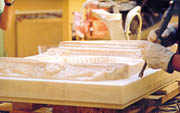

Within Monaco, situated on a splendid rocky spur penetrating into the sea, rises a cathedral not far from the Palace of the Princes. Built in 1875 on the same site as the ancient Church of San Nicola (14th century) it preserves the remains of the Princes and Princesses, among which, the still-mourned Princess Grace Kelly.
For some years, the cathedral -- so important for a principality supporting the papacy throughout the centuries -- has been object of some restoration works. The last of these efforts was dedicated to a marble altar that dates to the late 1800s. The work is defined by a vitreous mosaic containing the relics of Santa Devota, the patron saint of Monaco, who is memorialized on January 27 of each year with a procession through the streets of Monaco and a solemn mass in the cathedral.
This restoration effort finally returned the altar to the devotees of the saint, having been moved from the Chapel of the Princes, which is closed to the public, into another chapel located adjacent to the cathedral.
The Monaco Department of Public Works assigned the task of restoring the altar to Piero Zanella S.r.l. of Soave, Verona, Italy. The firm, which has three generations of experience in natural stone, had already completed a variety of projects within Monaco, including banks, shops and residences.
"Given the prestige and the delicacy of the work, I decided to follow the entire job personally, which lasted about four weeks, and to make use only of my best collaborators," said the proprietor firm, Piero Zanella. "From the beginning, I realized that the job was very complex because it not only required thorough knowledge of natural stone, but also the mastery of various techniques of working marble, such as fixing, gluing and filling. The project combined the methods of the past, as well as the capacity of choosing the most proper machinery for use in the inside of a cathedral."
The tools for the project were fairly basic, according to Zanella. "We designed and built a specific metal structure with dimensions suited to the chapel, which we used for lifting, and we also used hydraulic jacks that were modified for our needs. The most delicate work, such as reconstructing the pieces and decorations, were executed by hand with the typical tools and the manual skill of the stone cutter."
The most difficult aspect of the project was dismantling the capital containing the relics of Santa Devota from the central body of the altar. "We proceeded with extreme caution, cutting only the cement base in order to preserve the piece and reinforcing the tabernacle from its inside," Zanella said. "[This allowed us] to raise it in a single piece wrapped up in a solid wooden box."
In addition to the altar of Santa Devota, Zanella also dismantled and moved another minor altar using the same methods, and they also restored a 13th century wall tabernacle in Bianco Statuario, which had been lying forgotten in a storehouse for many years. "We started with a minute cleaning of the piece using small brushes and then, since the stone was very broken, we decided to reinforce it on the back side with some steel clamps," Zanella said. "On the front side, we had to fill [large pores] with sealing wax and epoxy resin, and we made some small repairs using the same type of stone. After this, the surface of the tabernacle was painted with a special mixture of natural ingredients to obtain a natural antique-effect."
The restored wall tabernacle was then installed in the wall of the same chapel where workers installed the altar of Santa Devota. "The effect obtained is very impressive," Zanella said. "We have fixed the tabernacle in a frame of the same material so that the artistic surface seems to be coming out of a block of Bianco Statuario stone."
Although Piero Zanella S.r.l. works on a broad range of projects, including new cut-to-size construction, the company welcomed the opportunity to work on the classic stonework. "We have a structure and equipment that allows us to work also on important large commercial projects, which is our most important market at the moment, but we also keep using the experience of the artisan," Zanella said. "The love, passion and enthusiasm for the work are essential requirements."